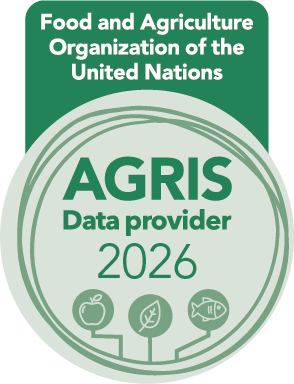Toxicity of selected insecticides to different stages of brown lacewing,Micromus timidus Hagen (Neuroptera: Hemerobiidae)
DOI:
https://doi.org/10.24154/jhs.v20i1.2911Keywords:
Hemerobiidae, toxicity, Micromus timidus, Potter spray towerAbstract
Brown lacewings belong to the family Hemerobiidae and is the third largest family belonging to order Neuroptera. These are brown, small to medium-sized insects with moniliform antennae and are predators both in larval and adult stages, which feed exclusively on aphids. Investigation was made to study the sensitivity of Micromus timidus Banks to selected insecticides and the experiment was carried out in the Department of Entomology, University of Agricultural Sciences, Bengaluru. For the studies, five different insecticides (profenophos 50EC, imidacloprid 17.8SL, lambda-cyhalothrin 5EC, chlorantraniliprole 18.5SC and buprofezin 25SC) and a neem product (azadirachtin 10000 ppm) were selected based on the recommendation for aphid management in pulses. The toxicology studies were carried out by using the Potter spray tower and safety studies were carried out for all the four stages of M. timidus (egg, larva, pupa and adult). Control with water spray was maintained. For the egg and adult stages, imidacloprid 17.8SL at 0.5 mL/L was highly toxic causing 89.74 and 74.07 per cent mortality respectively, followed by profenophos 50EC at 3 mL/L (52.37 and 66.67 per cent mortality). The larval and pupal stages were very sensitive to profenophos 50EC at 3 mL/L causing 100 and 96.29 per cent mortality respectively, followed by imidacloprid 17.8SL at 0.5 mL/L (51.85 and 55.56 per cent mortality respectively). Azadirachtin 10000 ppm was found to be the safest insecticide to all stages of M. timidus, causing less than 20 per cent mortality, which was followed by buprofezin 25EC and chlorantraniliprole 18.5SC.
Downloads
References
Farahi, S., Sadeghi, H., & Whittington, A. E. (2009). Lacewing (Neuroptera: Chrysopidae & Hemerobiidae) from northeastern and east provinces of Iran. *Munis Entomology and Zoology, 4*(2), 429-437.
Gandhi, P. I., Gunasekaran, K., Poonguzhali, S., Anandham, R., Kim, G. H., Chung, K. Y., & Sa, T. (2005). Laboratory evaluation of relative toxicities of some insecticides against *Trichogramma chilonis* (Hymenoptera: Trichogrammatidae) and *Chrysoperla carnea* (Neuroptera: Chrysopidae). *Journal of Asia-Pacific Entomology, 8*(4), 381-386. https://doi.org/10.1016/S1226-8615(08)60267-8
Garland, J. A. (1978). Reinterpretation of information on exotic brown lacewings (Neuroptera: Hemerobiidae) used in biocontrol programme in Canada. *Manitoba Entomologist, 12,* 25-28.
Golmohammadi, G., & Hejazi, M. J. (2014). Toxicity and side effects of three insecticides on adult *Chrysoperla carnea* (Neu: Chrysopidae) under laboratory conditions. *Journal of the Entomological Society of Iran, 33*(4), 23-28.
Ham, E. H., Lee, J. S., Jang, M. Y., & Park, J. K. (2019). Toxic effects of 12 pesticides on green lacewing, *Chrysoperla nipponensis* (Okamoto) (Neuroptera: Chrysopidae). *Entomological Research, 49*(7), 305-312. https://doi.org/10.1111/1748-5967.12366
Jeevanandham, N., & Ganapathy, N. (2020). Effect of chlorpyriphos 20EC on predatory green lacewing *Chrysoperla zastrowii sillemi* under laboratory condition. *Journal of Pharmacognosy and Phytochemistry, 9*(3), 1162-1165.
Khan, A. M., Khan, A. A., Afzal, M., & Iqbal, M. S. (2012). Wheat crop yield losses caused by the aphid infestation. *Journal of Biofertilizers and Biopesticides, 3,* 2-7. https://doi.org/10.4172/2155-6202.1000122
Kovanci, O. B., Canbulat, S., & Kovanci, B. (2014). The brown lacewings (Neuroptera: Hemerobiidae) of northwestern Turkey with new records, their spatio-temporal distribution and harbouring plants. *Revista Brasileira de Entomologia, 58*(2), 147-156. https://doi.org/10.1590/S0085-56262014000200006
Mathirajan, V. G., & Regupathy, A. (2002). Effect of thiamethoxam 25 WG (ACTARA Reg) on *Chrysoperla carnea*. *Annals of Plant Protection Sciences, 10,* 374-375.
Medina, P., Budia, F., Estal, P., & Vinuela, E. (2003). Effect of three modern insecticides, pyriproxyfen, spinosad, and tebufenozide on survival and reproduction of *Chrysoperla carnea* adults. *Annals of Applied Biology, 142*(1), 55-61. https://doi.org/10.1111/j.1744-7348.2003.tb00229.x
Navi, S. S. (2009). *Exploitation of Micromus igorotus Banks and Micromus timidus Hagen (Hemerobiidae: Neuroptera) in the management of aphids in cotton and tobacco* (Doctoral dissertation, University of Agricultural Sciences, Dharwad).
Neuenschwander, P., Hagen, K. S., & Smith, R. F. (1975). Predation on aphids in California's alfalfa fields. *Hilgardia, 43,* 53-78. https://doi.org/10.3733/hilg.v43n02p053
New, T. R. (2002). Prospects for extending the use of Australian lacewings in biological control. *Acta Zoologica Academiae Scientiarum Hungaricae, 48*(2), 209-216.
Oswald, J. D. (2004). Review of the brown lacewing genus *Biramus* (Neuroptera: Hemerobiidae: Hemerobiinae), with the description of a new species from Costa Rica and Panama. *Tijdschrift voor Entomologie, 147,* 41-47. https://doi.org/10.1163/22119434-900000135
Pekas, A., De Smedt, L., Verachtert, N., & Boonen, S. (2023). The brown lacewing *Micromus angulatus*: A new predator for the augmentative biological control of aphids. *Biological Control, 186,* 105342. https://doi.org/10.1016/j.biocontrol.2023.105342
Potter, C. (1952). An improved laboratory apparatus for applying direct sprays and surface films, with data on the electrostatic charge on atomized spray fluids. *Annals of Applied Biology, 39*(1), 1-28. https://doi.org/10.1111/j.1744-7348.1952.tb00993.x
Smith, B. C., & Coppel, H. C. (1957). Releases in North America and reviews of binomics in Europe of insect predators of the balsam woolly aphid, *Adelges piceae* (Ratz.) (Homoptera: Adelgidae). *Canadian Entomologist, 89,* 410-420. https://doi.org/10.4039/Ent89410-9
Tauber, C. A., Tauber, M. J., & Albuquerque, G. S. (2009). Neuroptera: Lacewings, antlions. In V. H. Resh & R. T. Cardé (Eds.), *Encyclopedia of insects* (pp. 625-634). Academic Press. https://doi.org/10.1016/B978-0-12-374144-8.00190-9
Vidya, M. (2007). *Exploitation of Micromus igorotus Banks (Neuroptera: Hemerobiidae) in the management of sugarcane woolly aphid Ceratovacuna lanigera Zehntner* (Doctoral dissertation, University of Agricultural Sciences, Dharwad).
Vidya, M., Lingappa, S., Patil, R. K., & Ramegowda, G. K. (2008). Toxicity of chemicals and entomopathogenic fungi to different stages of brown lacewing, *Micromus igorotus* Banks (Neuroptera: Hemerobiidae). *Pesticide Research Journal, 20*(2), 163-166.
Williams, F. X. (1927). The brown Australian lacewing (*Micromus vinaceus*). *Hawaiian Planters' Record, 31,* 246-249.
Downloads
Published
Issue
Section
License
Copyright (c) 2025 S Bhavana, Vidya Mulimani, N Sumithramma, K Murali Mohan (Author)

This work is licensed under a Creative Commons Attribution-NonCommercial-ShareAlike 4.0 International License.
Authors retain copyright. Articles published are made available as open access articles, distributed under the terms of the Creative Commons Attribution-NonCommercial-ShareAlike 4.0 International License, which permits unrestricted non-commercial use, distribution, and reproduction in any medium, provided the original author and source are credited. 
This journal permits and encourages authors to share their submitted versions (preprints), accepted versions (postprints) and/or published versions (publisher versions) freely under the CC BY-NC-SA 4.0 license while providing bibliographic details that credit, if applicable.







 .
. 











